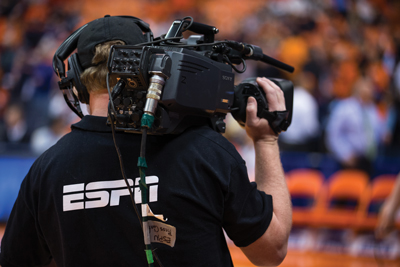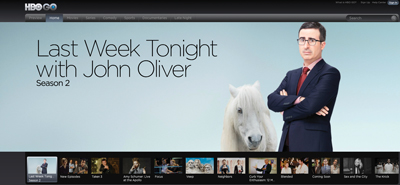University of Maryland students Jon Banister and Gabe Weintraub are typical young adults in at least one respect — they both use several different user names and passwords to watch video online.
They pay for none of them.
The 22-year-old Banister, a senior journalism major, watches Netflix via his parents’ account; he accesses streams of WatchESPN and NFL RedZone thanks to his roommates’ parents’ FiOS accounts; and he catches up on HBOGo with a user name and password that belongs to the parents of an ex-girlfriend.
Banister’s friend, the 20-year-old Weintraub, uses different passwords but tells a similar story. A junior finance major in College Park, Md., Weintraub accesses Netflix from his family’s account, Hulu from his roommates’ family, WatchESPN from the family of one friend he has known since high school, and HBOGo from another high school friend.
 |
Some worry that college students sharing passwords will maintain their resistance to paying for video as they grow older.
Photo by: GETTY IMAGES
|
The cable industry’s six-year TV Everywhere rollout has created this type of market, one where young adults like Banister and Weintraub share online passwords as naturally as they share Snaps and Instagram photos. Search the Internet for “WatchESPN” and “password” during any big game on the network, and you’ll find dozens of password-sharing requests from people who don’t have cable subscriptions.
Each sports network contacted for this story has employees monitoring what gets shared online. But the networks and their distribution partners surprisingly are quiet when it comes to shutting down those accounts.
On one hand, it’s easy to look at the situation on college campuses and declare that password sharing is hurting the pay-TV industry by causing people to cut the cord. After all, why would people pay for video if they can get it for free, right?
But most industry leaders describe the threat of password sharing as overly hyped these days. Executives from four of the country’s biggest distributors and the top U.S. sports networks say the password-sharing trend is getting much more attention than it deserves. So far, they see no correlation between sharing passwords and cutting the cord.
“We don’t have a sense that it’s having any sort of material impact,” said David Bank, managing director of equity research for RBC Capital Markets, who follows trends like this. “I didn’t pay for cable when I was in college, either.”
Comcast, the country’s largest cable operator, says that about one-third of its subscriber base — more than 7 million subscribers — use TV Everywhere every month. Those subscribers watch, on average, about 8 1/2 hours of programming per month, a figure that is up 22 percent year-over-year.

“That’s a very small fraction of the total amount of video that the average person watches a month,” said Matt Strauss, Comcast’s executive vice president and general manager of video services. “TV Everywhere usage just isn’t big enough. If it was really contributing to cord cutting, I would expect to see a lot higher consumption of hours per month than what we’re seeing.”
AT&T, which merged with DirecTV three months ago, delivered the same message. “We see no evidence that password sharing is an imminent threat to our TV Everywhere business,” the company said in an emailed statement.
These are not executives with their heads in the sand. They all know that password sharing occurs, especially around college campuses. But they all believe that password sharing is not hurting their business.
 |
ESPN plans to implement a new password-tracking system by the end of the year.
Photo by: GETTY IMAGES
|
“We’re monitoring it closely but do not feel it’s a major issue at this time,” said Rick Cordella, senior vice president and general manager of digital media for NBC Sports Group.
The question is whether password sharing has the potential to grow into a major issue. Some skeptics believe it can. Gone are the days when TV Everywhere authentication was a clumsy multistep process. It’s become much easier for subscribers to log in and watch TV online, which also means that it has become easier for nonsubscribers to access that same programming for free.
“Everyone shares passwords,” said Banister, who lives in an off-campus apartment. “When I have a paycheck, maybe I’ll buy these on my own. Right now, I’m just not in a position to pay to get my own subscriptions.”
As the cable TV industry continues losing subscribers to cord cutting — Nielsen estimates that pay-TV distribution shed 4 percent of its homes in the past 12 months alone (see chart below) — some have pointed to this kind of password sharing as a primary reason.
Investment bank Jefferies & Co. made headlines this month with a report that pointed to password sharing among millennials as the most significant reason for the cord-cutting trend. They worry that college students who get their video for free will turn into 20-somethings who will keep getting their video for free and, eventually, middle-aged consumers who will continue to resist paying for video.
Just last week, Verizon Chief Financial Officer Fran Shammo said on the company’s second-quarter conference call that millennials don’t want traditional television. “They’re disconnecting cable,” he said, which is why Verizon is pushing an ad-supported streaming video platform with big cable brands like Disney and Discovery to attract them.
What can be done?
The lack of overall concern over the password-sharing threat doesn’t mean that pay-TV companies are standing pat.
ESPN, for example, plans to implement a new password-tracking system by the end of the year that will make it more difficult for password sharers to access those streams. ESPN has been in talks with distributors about implementing these plans. ESPN needs distributors to buy into it for the plan to work.
“Password sharing is something that we definitely keep an eye on. It’s something of interest to us,” said Justin Connolly, executive vice president of Disney and ESPN affiliate sales and marketing. “The Walt Disney Co.’s view of the world is that digital piracy and unauthorized use on services like WatchESPN is something that we want to deal with and stamp out as much as possible.”
The plan is to limit the number of concurrent streams attached to a particular user name and password. ESPN’s plan is to limit the number of streams to five so that when a sixth stream is accessed, ESPN will create an “auto ejection” of the first stream.
The problem is that while ESPN can monitor the number of WatchESPN streams that are generated through ESPN’s online and mobile apps, it doesn’t know how many streams are accessed through distributor sites. Comcast is one distributor that has expressed interest in ESPN’s plan.
“Those will start to get centralized,” Strauss said. “There is technology that we have not enforced yet because we haven’t really seen the overall fraud and abuse that has gotten us to the point where we think we have a material issue. We can’t ever be content. We need to continue to monitor this closely. It is always possible that anything that starts small can get bigger.”
Though they say it has not had an impact on their businesses, distribution executives are taking steps to make sure that password sharing doesn’t become more widespread. Comcast and AT&T are putting the onus on their subscribers by syncing TV Everywhere user names and passwords with the log-ins consumers use to pay bills online, set DVRs or read email.

“Sharing credentials has consequences aside from violating terms of service,” Strauss said. “It’s also sharing personal information, which I think people are becoming a little bit more mindful of. It maybe gives you pause before giving someone a credential that you shouldn’t be doing it.”
Comcast set up an initiative called Xfinity On Campus that has cut deals with a couple dozen universities that makes a bare bones streaming service available to students on campus.
“In that sense, there’s really no reason to steal a credential because you’re getting our service in conjunction with the university where we’re able to provide you with a high-quality experience,” Strauss said. “We’re trying to be more surgical in how we get the right products to these segments to give them alternatives to stealing the service and giving them legitimate ways to get it. We’re finding great success there.”
Despite all the cord-cutting talk, Comcast lost only 69,000 households in the second quarter, a mark that company CEO Brian Roberts called in a prepared statement, “The best second quarter video customer results we’ve had in nine years.” Should password sharing become even more prevalent, Comcast, which allows up to five simultaneous streams from the same TV Everywhere user name and password, says it has tools in place to make it even more difficult to share passwords.
“If we ever needed to reduce the number of concurrent streams, we could even further,” Strauss said. “While we’re never going to be content, there’s nothing at the moment that gives us the ability to conclude that there’s a material widespread concern. We are mindful that it happens. And when it does happen, we do try to enforce our terms of service to ensure that people are in compliance. But it’s hard for me to say at this moment that there’s a widespread concern.”
 |
HBO sees password sharing as a way for consumers to become avid followers of programming who would eventually pay for it.
|
To that end, ESPN also has targeted five concurrent streams as the ideal amount so far.
“It’s a work of progress,” Connolly said. “For in-home multichannel pay-TV subscription, where the average house has roughly three televisions in three separate locations, the concept expands there. We don’t see any issue with that. We think it’s consistent with the in-home experience and the licensing mode.”
In some cases, networks and cable providers encourage young adults like the University of Maryland’s Banister and Weintraub. Networks and cable providers want consumers to sample programming more frequently by allowing homes to have many concurrent streams running at the same time.
HBO executives, in particular, have been open about saying that password sharing is not pervasive enough to be a problem. CEO Richard Plepler has said that he wants to create “addicts” of his programming who eventually will pay for it.
Connolly understands the view that networks should allow consumers to sample their programming.
“The WatchESPN experience can be an interesting sample opportunity in terms of taking the access to ESPN out to as many devices and platforms as possible to reach that younger audience,” he said. “At the same time, we don’t bury our heads in the sand on this one. We are not OK with the idea of having widespread usage among unauthenticated, unauthorized users.
“There is a delicate balance in terms of it being a sampling opportunity allowing sharing within a household among various members of that household and yet ensuring that you don’t have dozens and dozens of people who aren’t in any way connected to the pay-TV subscription using the product regularly.”
ESPN, ESPN2 and ESPN Classic have lost more subscribers since October 2011 than any other sports network, according to Nielsen household estimates.
ESPN and ESPN2 have seen 7 percent declines from October 2011 to October 2015, and ESPN Classic is down almost 24 percent. During the same time period, the pay-TV industry’s distribution footprint is down nearly 4 percent. The drop hurts ESPN, which is the priciest national channel by far, with distributors paying more than $6.50 per subscriber per month, according to SNL Kagan.
Some industry analysts blame the distribution problems on distributors’ strategy to provide low-cost bundles that don’t include high-cost channels like ESPN.
“The reduction in ESPN subscribers is outpacing the reduction in overall pay-TV subscribers,” said David Bank, managing director of equity research for RBC Capital Markets. “This phenomenon is more about lighter bundles that don’t carry ESPN than cord-cutting.”
ESPN executives, however, point to Sling TV as evidence that its channels can be part of any low-cost bundle. Sling TV’s over-the-top service carries around 23 channels, including ESPN and ESPN2, for $20.
— John Ourand
| NETWORK |
OCTOBER 2011 |
OCTOBER 2012 |
OCTOBER 2013 |
OCTOBER 2014 |
OCTOBER 2015 |
5-YEAR CHANGE |
| TBS |
99,796 |
99,375 |
100,489 |
97,036 |
94,602 |
-5.2% (-5,194) |
| TNT |
99,011 |
98,430 |
99,294 |
95,870 |
93,294 |
-5.8% (-5,717) |
| ESPN |
98,648 |
98.179 |
98,891 |
95,256 |
91,772 |
-7.0% (-6,876) |
| ESPN2 |
98,470 |
18,126 |
98,861 |
95,233 |
91,679 |
-6.9% (-6,791) |
| TruTV |
91,407 |
91,796 |
92,343 |
90,138 |
90,023 |
-1.5% (-1,384) |
| FS1 |
77,394 |
80,792 |
90,121 |
85,186 |
84,434 |
9.1% (+7,040) |
| NBCSN |
74,989 |
78,068 |
79,145 |
81,767 |
83,623 |
11.5% (+8,634) |
| Golf |
82,934 |
83,944 |
82,964 |
79,841 |
77,077 |
-7.1% (-5,857) |
| ESPNU |
71,948 |
73,258 |
75,603 |
73,882 |
71,445 |
-0.7% (-503) |
| ESPNews |
73,264 |
74,319 |
75,829 |
72,666 |
69,744 |
-4.8% (-3,520) |
| NFL Network |
56,550 |
62,093 |
72,464 |
72,203 |
69,032 |
22.1% (+12,482) |
| MLB Network |
67,220 |
69,811 |
71,026 |
69,882 |
66,564 |
-1.0% (-656) |
| NBATV |
54,400 |
59,845 |
59,950 |
57,566 |
53,933 |
-0.9% (-467) |
| FS2 |
31,750 |
35,943 |
37,271 |
44,840 |
47,827 |
50.6% (+16,077) |
| Univision Deportes |
N/A |
N/A |
N/A |
37,674 |
45,897 |
N/A |
| ESPN Classic |
32,648 |
31,219 |
30,826 |
27,012 |
24,917 |
-23.7% (-7,731) |
| Fox Deportes |
N/A |
N/A |
21,193 |
21,258 |
21,560 |
N/A |
| BeIN Sport |
N/A |
N/A |
N/A |
14,071 |
18,793 |
N/A |
| Total Pay TV |
103,840 |
103,137 |
104,548 |
104,246 |
99,798 |
-3.9% (-4,042) |
| Total US HH |
114,700 |
114,200 |
115,800 |
116,400 |
116,400 |
1.5% (+1,700) |
Notes: Speed relaunched as Fox Sports 1 in August 2013. Versus relaunched as NBC Sports Network in January 2012. Fuel became Fox Sports 2 in August 2013.
NA=Not available
Source: Nielsen








